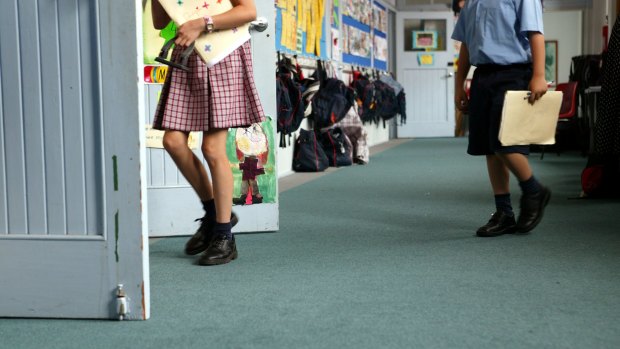Opinion
A great leap forward for school children (as long as we don’t forget their teachers)
By Jordana Hunter and Nick Parkinson
School education took a big step forward in NSW this week. The state government unveiled a new and better primary school syllabus that sets out a more ambitious vision of what children should learn in their first seven years at school.
But the government should be under no illusions about the amount of work that will be needed to support teachers to implement this new syllabus in their classrooms. Failing to invest enough in this transition will not just mean a missed opportunity for NSW children; it will risk further stretching an already harried teaching profession.

The kids will be all right, so long as their teachers are trained in the new syllabus.Credit: Michele Mossop
Overhauling the NSW syllabus is a big deal. The syllabus sets out the content that about 800,000 students in 2000 government schools across the state must be taught. This is the first time in 50 years that the NSW primary syllabus has been reviewed holistically. Getting the changes right really matters.
A well-designed syllabus takes the guesswork out of what teachers need to cover in their classrooms and helps ensure students have the opportunity to learn the same things at the same pace, whether they live in Grafton or Potts Point. But a poorly designed syllabus can create additional workload for teachers and perpetuate a “lesson lottery”, where what is taught in each classroom is left to chance.
The good news is that the new NSW syllabus contains welcome improvements that – if implemented well – will benefit students and teachers. Compared with the previous version, it is more explicit about the specific knowledge students should be taught. It should also help teachers build on each other’s instruction and reinforce learning.
For example, the syllabus now expects year 3 and year 4 teachers to explain to students in maths class how to interpret graphs, and then have students apply this knowledge in their humanities lessons to interpreting graphs of seasonal rainfall.
The new syllabus also raises the ambition for what primary students will learn. In science, for example, year 3 and year 4 students will learn about invertebrates and vertebrates, and explore the human skeletal system, establishing stronger foundations for future studies in biology.
These revisions recognise that learning is cumulative, and that building background knowledge is crucial to prepare primary students for the challenges of secondary school and beyond.
But revising the syllabus is the easy part. The government must not underestimate the implementation challenge, especially for a workforce that has communicated loud and clear that it’s struggling with onerous workloads.
Just as this new syllabus expects more from students, teaching it well will also demand a higher level of subject knowledge from teachers. Many teachers will need significant support to feel confident bringing the new syllabus to life in their classrooms.
There are three ways the state government can support the transition.
First, curriculum materials (such as textbooks, lesson handouts and PowerPoints) link the syllabus to effective classroom teaching. But primary schools can’t be expected to create high-quality curriculum materials on their own. Grattan Institute research has found it takes about 500 hours to develop a year’s worth of curriculum materials for just one year-level subject, such as year 6 English. Most primary teachers teach multiple subjects and often find themselves mired in endless planning.
Having ready access to high-quality curriculum materials can save the typical teacher three hours a week and boost student achievement by two months a year. But principals and teachers in Australia currently lack reliable information about which curriculum materials are most effective.
To tackle this problem the NSW government should support the establishment of an independent quality-assurance body to review curriculum materials aligned to the new syllabus, including any materials the government creates for teachers.
Second, primary teachers will need rigorous, subject-specific training to effectively implement the new syllabus. Principals will need targeted professional learning, too, because they will play a key role in leading change in their school.
Finally, once the new syllabus is fully implemented, NSW should strengthen school reviews so they thoroughly examine how well the new syllabus is being implemented in classrooms.
If the state government gets this right, NSW could cement itself as the nation’s leader in primary school education. This new syllabus is a strong first step. Now comes the hard part.
Dr Jordana Hunter and Nick Parkinson are in the education program at the Grattan Institute.
Get a weekly wrap of views that will challenge, champion and inform your own. Sign up for our Opinion newsletter.